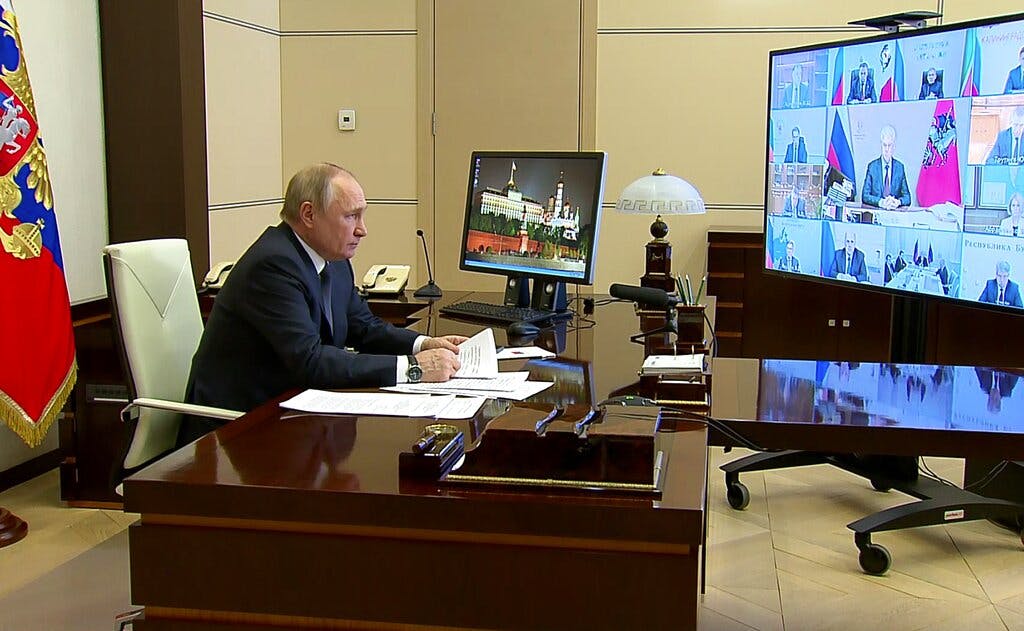Similar to Stalin, Putin Is Purging His Forces
Sources close to Russia’s Ministry of Defense have described the Russian strongman’s descent into self-isolating megalomania.

Echoes of Tukhachevskii
The unraveling of the Russian army in Ukraine has triggered a military purge that, while much smaller in scale, brings to mind Stalin’s cull of the Red Army officer corps during the late 1930s.
Vladimir Putin had the chief and deputy chief of foreign intelligence at Russia’s Federal Security Service arrested last week. This was followed by the imprisonment of General Roman Gavrilov, on charges of leaking national security information and “wasteful squandering of fuel.”
The 45-year-old Gavrilov was second-in-command of the “Rosgvardia,” the national guard force directly answerable to the Russian president’s office and responsible for internal security. The Center for European Policy Analysis describes the Rosgvardia as Mr. Putin’s “enforcers and protest bashers” who are “notorious for special brutality toward the population.”
Princeton’s Stephen Kotkin, an acclaimed biographer of Stalin, argues in the Atlantic that Mr. Putin represents the latest chapter in a recurrent pattern of Russian history, where the national interest is conflated with the ruler’s personal benefit: “You have an autocrat in power—or even now a despot—making decisions completely by himself. Does he get input from others? Perhaps. We don’t know what the inside looks like. Does he pay attention? We don’t know. Do they bring him information that he doesn’t want to hear? That seems unlikely. Does he think he knows better than everybody else? That seems highly likely. Does he believe his own propaganda or his own conspiratorial view of the world? That also seems likely.”
Writing in Foreign Affairs, Dimitri Alperovich cites sources close to Russia’s Ministry of Defense who describe Mr. Putin’s descent into self-isolating megalomania: “Vladimir Putin appears to have concealed his military plans from even his closest advisers until the last possible moment. Already an unusually paranoid leader, Putin was so obsessed with keeping his intentions secret that he kept many military officials and members of his national security council in the dark about the timing and scope of the invasion.”
In 1937, Stalin conducted a purge of the Red Army that led to thousands of senior and mid-level officers being shot or banished to Siberian gulags. The most famous of those purge victims was Marshal Michael Tukhachevskii, a brilliant military strategist nicknamed the Red Napoleon who was executed alongside seven other Russian generals in July of that year. Most military historians blame the Red Army’s poor performance during the Winter War with Finland and Operation Barbarossa on Stalin’s defenestration of the Russian officer corps during the 1930s.
Beyond the vast difference in scale — so far at least — there’s also a chicken-and-egg distinction between Stalin’s wholesale purge of the Red Army and Mr. Putin’s arrest of a half-dozen senior military officers. In Stalin’s case, the purge was the cause of Russia’s military dysfunction, while for Mr. Putin it’s the consequence of pre-existing Russian military incompetence.
While it’s too early to tell whether these arrests indicate genuine slippage in Mr. Putin’s grasp on power, it’s fair to say that they don’t bode well for his lease on political — and perhaps literal — life.
Izyum
The Russian army’s attempt to threaten the flank of Ukrainian forces defending against pro-Putin separatists in the Donbas region has been repulsed with heavy losses. Ukrainian sources report that Russia’s 252nd Motorized Rifle Regiment lost 30 percent of its combat strength in a failed assault on the town of Izyum, southeast of Kharkiv.
If this information is accurate, and the Russian advance in the Izyum sector has indeed stalled, the tactical consequences are that Ukrainian defenses in the country’s south remain tenable and intact.
Stalemate
Russian units are seen gaining no real headway in the face of fierce Ukrainian opposition around Ukraine’s two largest cities, Kiev and Kharkiv. Analysts at Maxar Technologies cited satellite imagery to demonstrate how “Russian forces are increasingly using using earthen revetments (berms) to protect/conceal their armored equipment deployments near Antonov Airport in Hostomel.” This may indicate that the Russian army is not planning to conduct maneuver operations any time soon.
Slip-Slidin’ Away
Civilian smartphone footage shows four helicopters being trucked away for repair after an attack on a forward Russian airfield in the occupied Ukrainian city of Kherson. These aircraft were too seriously damaged to fly.
Mariupol
Russia’s bombing of a Mariupol theater reportedly sheltering hundreds of civilians generated harsh condemnation from the U.S. government. Speaking to reporters on March 17, Secretary of State Blinken described this attack as a war crime, noting that the word “children” was written in giant, white Cyrillic letters outside the building. President Biden went a step further, personalizing this accusation by labeling Mr. Putin a “war criminal.”
A final casualty count from the attack on the Mariupol theater is as yet unknown, but more than 130 survivors are reported to have so far emerged from the building’s cellar.

